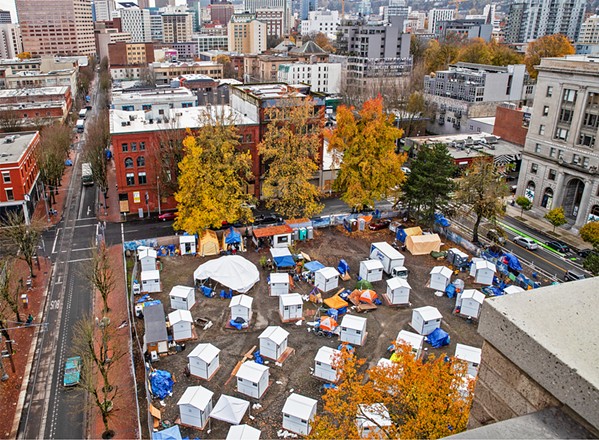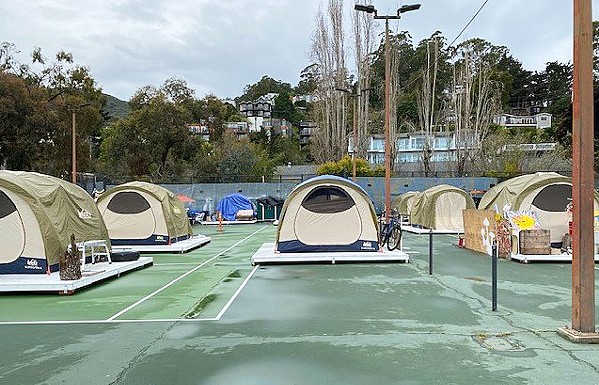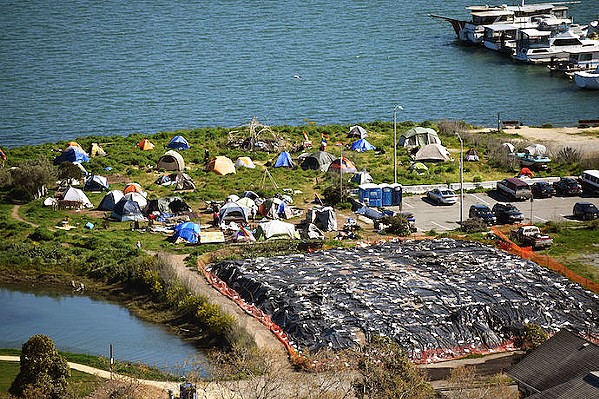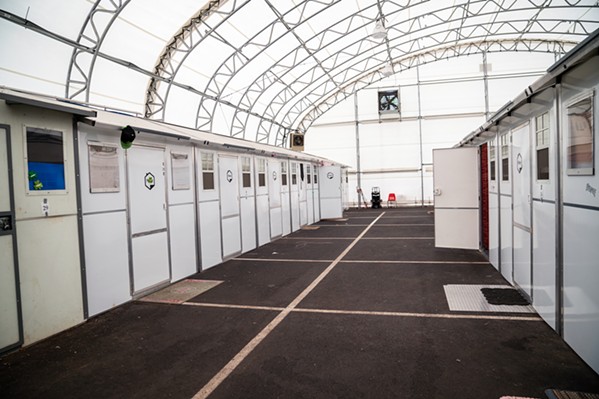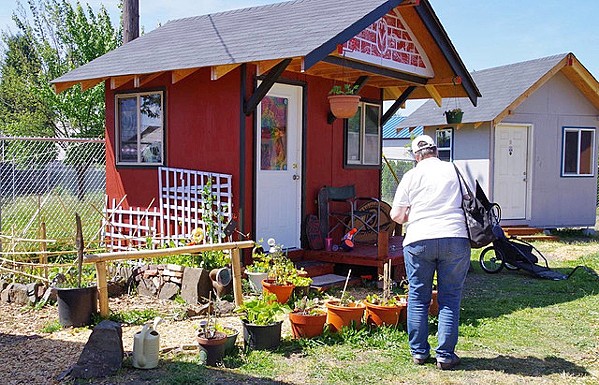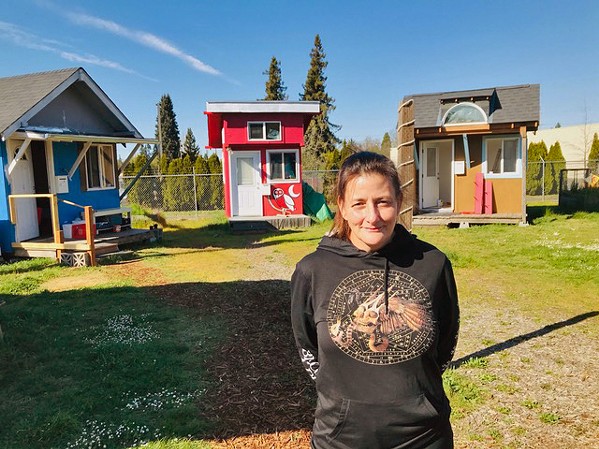Space for stability: Temporary Pallet shelters are just one way that communities are trying to stem the tide of homelessness
By New Times Staff[{
"name": "Newsletter Promo",
"id": "NewsletterPromo",
"class": "inlineCenter",
"insertPoint": "4",
"component": "15264767",
"requiredCountToDisplay": "0"
},{
"name": "Ad - Medium Rectangle CC01 - 300x250",
"id": "AdMediumRectangleCC01300x250",
"class": "inlineCenter",
"insertPoint": "8",
"component": "2963441",
"requiredCountToDisplay": "12"
},{
"name": "Ad - Medium Rectangle LC01 - 300x250",
"id": "AdMediumRectangleCC01300x250",
"class": "inlineCenter",
"insertPoint": "18",
"component": "2963441",
"requiredCountToDisplay": "22"
},{
"name": "Ad - Medium Rectangle LC09 - 300x250",
"id": "AdMediumRectangleLC09300x250",
"class": "inlineCenter",
"insertPoint": "28",
"component": "3252660",
"requiredCountToDisplay": "32"
}]
What's the solution to homelessness?
"It is apparent that there is not panacea to solve this complex problem, as it is diverse and nuanced," Katie Grainger wrote in a letter to the SLO County Board of Supervisors as the chair/facilitator of Public Safety SLO. "However, I fully believe that a tiny-house village is an appropriate step in the right direction, one which the community can get behind across sectors to unite and support."
Tiny-home villages are just one proposed potential solution to the homelessness issue in SLO County. While the village concept is still just an idea on the Central Coast, tiny-home shelters are a reality in other places, as are a variety of other innovative approaches.
New Times spoke with several communities and organizations spearheading those projects to learn more about how effective they were at providing services to homeless individuals and getting a more permanent roof over their heads.
Sanctioned camps
Santa Rosa's approach to homelessness evolved out of necessity during the COVID-19 pandemic.
In May 2020, as homeless encampments multiplied in the Northern California city and the threat of a COVID-19 outbreak grew, officials scrambled to establish Santa Rosa's first sanctioned encampment, located in the parking lot of a city park and community center.
"We were not open to doing a sanctioned encampment prior to that, but I'd say the pandemic forced us to try new things and step outside of our comfort zone," said Kelli Kuykendall, Santa Rosa's housing and community services manager. "At that point in time, we didn't know a lot about COVID-19 and how it might impact our homeless population. The city owns a shelter, but congregate shelter was not a good idea at the time."
The city-managed encampment was large enough to host about 70 tents—each spaced 12 feet apart. Santa Rosa and its nonprofit partners provided toilets, showers, hand-washing stations, security, trash assistance, and various social and medical services to its residents.
After an initial wave of opposition to the project, Kuykendall said that the Santa Rosa community came to accept—and even embrace—the campsite, which drew in dozens of unhoused individuals over a six-month period.
"I had at least 100 questions and complaints in advance of our first virtual community meeting. ... There was a strong opposition prior to us opening," Kuykendall remembered. "And after that, we had very few complaints and didn't really see any increases in calls for service. In the end, it certainly wasn't perfect. But, overall, the feedback was positive."
Santa Rosa isn't the only California city to look to sanctioned encampments as a temporary stopgap to the sprawling problem of unsheltered homelessness. Cities like San Jose, Sausalito, Los Angeles, San Francisco—and even Paso Robles—have also tried them in recent years, to varying degrees of success.
Despite Santa Rosa's success with an encampment, the city shuttered the parking lot site in November 2020. The project was always meant to be temporary, Kuykendall said, and officials were concerned about how the camp would hold up during the winter.
Today, Santa Rosa operates a safe parking site for unhoused residents living in their vehicles.
"What we're seeing as the greatest need is people in their RVs and vehicles," Kuykendall said. "We do still have tent encampments, but the majority are vehicles. We don't have any plans right now to do a managed [encampment] site."
Sanctioned encampments have been short-lived in other cities, too. In 2018, the city of San Jose experimented with Hope Village—a sanctioned encampment of about 17 residents near the international airport. But after a year, the Federal Aviation Administration broke it up—saying it was too close to the airport. The city never found a replacement location.
Some sanctioned encampments, like Sausalito's, have a checkered record. Officials in the bayfront city opened an encampment on city tennis courts last year after homeless advocates filed a lawsuit over the city's handling of an unsanctioned encampment near the San Francisco Bay. But the tennis court encampment made headlines for the wrong reasons this past February, when one of its 28 residents lit a tent on fire, causing a propane tank inside to explode.
Despite some challenges of sanctioned encampments—including their cost (Santa Rosa's cost nearly $700,000 to operate)—Kuykendall said that they are very effective at attracting more service- or shelter-resistant populations. They also help reduce the impacts of unsanctioned encampments.
"The best thing we learned is that people will come in—people who have been resistant previously to come into previous shelter models," Kuykendall said.
While it's never a long-term solution to homelessness, a sanctioned encampment can also be a valuable touchpoint for services or a first step to permanent housing. Santa Rosa had some success at housing individuals who stayed at its encampment, Kuykendall said.
"That was really our focus—that this is not the end destination," she said. "Let's stabilize people and house them."
The whole person
Many individuals experiencing homelessness need medical attention, mental health care, social services, or substance abuse treatment in addition to shelter. But it can be difficult to find a place to live—and stay there—without addressing those other needs, said Melora Martin, a senior strategist with the California Health Care Foundation.
"We often find particular people experiencing homelessness don't necessarily present with, 'I need housing.' They present with, 'I need care for this pain I'm having, or symptom I'm having.' [Addressing this] can be a gateway to the other services they need, including housing," Martin said.
This year, the Golden State is transitioning to a new program called Enhanced Care Management: a Medi-Cal-focused initiative designed to meet individuals experiencing homelessness where they are, and give them one point of contact who can help coordinate services to meet all of their needs—physical, dental, behavioral, and developmental care—as well as give access to social services, according to the California Department of Health Care Services.
Currently 25 of California's 58 counties have Enhanced Care Management programs specific to their needs, and Santa Barbara County's not too far behind as it completes a program application, said Department of Behavioral Wellness Chief Quality Care and Strategy Officer Susan Grimmesey.
"To have a true whole person care model, there has to be the funding so that you have the dedicated coordinators within each of those systems. You'd have this actual team, and that's something we don't have. We have good relationships and believe in it, but from a practical standpoint we don't have the designated teams," Grimmesey said.
If the application's approved by the Santa Barbara County Board of Supervisors and the state, the county could incorporate a housing retention team, life skills training, a tenant curriculum, and counseling services for individuals experiencing homelessness by September, she said.
"So often, we help individuals establish housing and assume now [that] they got the housing, they've got what they need. We know now how important it is to have a significant amount of support with independent living skills, life skills, benefits coaching, and having people on-site that can be there to provide support," Grimmesey continued.
Santa Barbara County looked to programs set up in Monterey and Alameda counties as models, Grimmesey said. The two counties were both a part of a 2016, five-year pilot program called Whole Person Care—which looked at coordinated service efforts for individuals experiencing homelessness, but wasn't a part of Medi-Cal yet—explained Alameda County Homeless Care and Coordination Director Kerry Abbott.
Alameda received $140 million from the California Department of Health Care Services to implement its pilot program—which ran until December 2020 and is transitioning to Enhanced Care Management this year—with a priority of helping individuals navigate housing applications, Abbott said.
"It takes a lot more than just showing up for an interview to make that work. Housing coordinators worked with clients on everything from accessing documents to moving into housing; from preparing for meetings [to] identifying preferences. Services were a huge part of Whole Person Care," she said.
According to 2020 Alameda County data, 299 people received intensive support through its Enhanced Housing Transition Service Bundle, and 1,691 people received landlord relations and dispute resolution coaching under its Housing and Tenancy Sustaining Service Bundle.
Although providing all the services a person may need is a move in a positive direction, the statewide housing crisis presents a barrier that services alone cannot overcome, Abbott added.
"What it really comes down to is the housing crisis in California is desperate. There's not enough housing, and it's extremely expensive," she said. "Whole Person Care was intended to address all of the barriers that people might be facing to improve their health, and housing is one of the biggest barriers."
Pallets with purpose
When the COVID-19 shelter-at-home mandate went into place in March 2020, 5 Cities Homeless Coalition (5CHC) Executive Director Janna Nichols had one question: "Where will my people shelter at home?" South SLO County doesn't have any homeless shelters.
SLO County Parks gave the coalition 10 spaces at the Coastal Dunes Campground to offer to people already in the organization's case management program. Out of the 10 people who participated in the two-month program, Nichols said, most ended up finding permanent housing.
"That program really helped me see that if people weren't swirling around trying to figure out where they were going to sleep at night, they had a better opportunity to focus on other things," Nichols said.
With the lessons from this program in mind, 5CHC is partnering with SLO County and the city of Grover Beach to implement a non-congregate shelter model on county-owned land in Grover Beach. The plan is to use modular cabins made by a Washington-based company called Pallet.
"When you first hear our company name, chances are wooden planks forged together might be one of the first images that come to mind," Pallet's website explained. "But unlike wooden shelters, ours are made of durable materials that won't rot."
In addition to a roof, Pallet shelters offer privacy: People have a space either all to themselves or shared with one roommate, a place to keep their belongings 24 hours a day, a bed, and a door that locks.
Tacoma was one of the earliest adopters. The city started its Pallet shelter program in 2017 and now has 58 of the structures.
"This site is their home for 24 hours a day: There's no 'out at this time and in at this time,'" said Megan Snow with the city of Tacoma. "When you are in a shelter situation where you have to vacate at 7 a.m., you have to leave with all of your stuff."
The Pallet model gives unhoused people one less thing to worry about, and acts as a stepping stone for people who aren't ready for permanent housing yet.
"When you don't have a place that's safe, you tend to lose some of those important governmental documents. You're not ready for those reasons," Snow said. "This is that intermediary step where caseworkers are on-site, they're helping you get all your paperwork back in place, and while you're doing that, you have a place where you can lock the door and your stuff is safe."
Since starting in 2017, the Tacoma program has served more than 570 individuals, and about 20 to 30 percent of them have transitioned to permanent housing. Snow said that's a higher rate than traditional congregate shelter models.
A bit closer to home, Good Samaritan Shelter in Santa Barbara County also implemented Pallet shelters, first in Isla Vista, and more recently in Lompoc. Brian Halterman, Good Sam's director of homeless and housing programs in Lompoc, said the main goal of the Pallet program is to provide "a sheltering opportunity for clients or homeless individuals who typically would not enter the traditional, mainstream, congregate living facilities."
"This option of having a smaller, personal area has been an opportunity for that," Halterman continued. "We have one individual who I've known for almost 14 years. They took this option when they would have never considered a shelter before."
Halterman talked about another client who dealt with extreme social anxiety, which stopped her from using congregate shelters in the past. But things have changed for her since coming into Lompoc's Pallet shelter program.
"Over the past two weeks, numerous times she's been over in the main shelter, sitting with groups of people, talking to them, which is something that wouldn't have happened when she first came into the place," Halterman said. "So [there's] those little victories that you see."
There are challenges that arise when dealing with a service-resistant population, Halterman said.
"The challenges have been helping them develop that trust that they're going to be OK, that we can help them," he said. "Even with the Pallets, there are policies and procedures that have to be followed, and for some, even with their own little living space, they just can't."
But the challenges, Halterman believes, are well outweighed by the success of the program.
"Without these Pallets, the 20-plus people we've been able to serve in the past six months would not have been served in a traditional setting," he said. "They would still be out living homeless within our river bottoms and in dangerous positions."
Building a community
In Oregon's Lane County, the success of one nonprofit's tiny-home shelters is measured both incrementally and by getting people in permanent housing.
"Successfully exiting our program would be a move to traditional permanent housing. Continued success within the program is getting along every day and achieving any number of goals. We want everybody to move towards permanent housing, but there are a lot of steps to that," SquareOne Village Coordinator Ian McBride said. "We don't have a time limit on how long people can stay here as long as they're meeting with the housing coordinator and working to get closer to housing, which can look so many different ways for different individuals."
Currently, the nonprofit runs Opportunity Village—a 30-unit tiny-home village on an acre of land. Open since 2013, the village charges $35 per month from participants. It rests on city-owned land that's leased to SquareOne for $1 every year. The shelter temporarily houses people while they get back on their feet before moving into more stable living situations. Residents can also transition to one of SquareOne's handful of co-op housing facilities.
But SquareOne needed support from the community it serves and elected officials before it could move forward with the concept.
"One of the things we do really well is building political will," said Amanda Dellinger, SquareOne's community relations director. "In 2021, we received $2 million from the Oregon state Legislature to develop one of the villages we're working on now. We just received another $3.3 million from advocacy work from one of our senators, $750,000 from the American Rescue Plan Act for some of our political relationships."
The SquareOne tiny village is a popular idea among San Luis Obispo County's homeless advocates. It was lauded at a tiny-village workshop organized by Hope's Village in March. After years of studying model sustainable community villages, its founder Becky Jorgeson teamed up with Nevada City architect Charles Durrett in hopes of finally getting the ball rolling for SLO County's first tiny village.
"It just takes political will. It will take the [SLO County] Board of Supervisors to say, 'We need to take better care of the people.' We don't have homeless people in Europe because they all say, 'It could be my brother.' That's what I want people to think here," Jorgeson told New Times.
Hope's Village already has a site in mind for its planned village of 30 tiny houses: one of the SLO Social Services building's unused parking lots at 3433 South Higuera St. It's close to offices and grocery stores, isn't surrounded by residential housing, and many homeless people already live in campsites nearby. Jorgeson said they've already vetted potential tiny-village residents.
"We have worked with them for five years at Saturday Showers," a project description states. "We know who is on drugs, who drinks and who does not. We know who wants to work hard to get into and keep housing, and we know who is not ready yet. We will pick and choose very carefully who is offered admission. We know who the drug-pushers are, and they will not be welcome."
Hope's Village does have support, as evidenced by letters sent to the Board of Supervisors from Public Safety SLO and SLO County District Attorney Dan Dow.
But Jack Lahey, the director of homeless services at Community Action Partnership of SLO, questioned the viability of tiny homes—though he added that he supports it.
"My criticism is rooted in what HUD [Department of Housing and Urban Development] will fund and what they will not fund. If they find a way around that, then great," he said. "If HUD is not recognizing it as an intervention, then they could potentially lose their homelessness status, which disallows them from other resources."
Dellinger, from Lane County's SquareOne, said the project doesn't receive HUD dollars for its tiny village because HUD only defines something as housing if it includes plumbing. SquareOne's tiny homes don't come with individual bathrooms, but residents share a common bathhouse and an outdoor kitchen. Their projects are funded through grants and public donations.
Jorgeson, too, said she's looking beyond HUD funding.
"We don't ask for or want government funding because we think we can do a better job," Jorgeson said. "I know everyone is working hard, but you just can't throw government money at homelessness and expect it to improve.
"In the end, it's not about housing but about community." Δ
Assistant Editor Peter Johnson, Staff Writers Bulbul Rajagopal and Malea Martin, and Sun Staff Writer Taylor O'Connor contributed to this story. Reach them through the editor at [email protected].
Latest in News
Comments (3)
Showing 1-3 of 3
Readers also liked…
-

Coast Unified teachers upset over new position's salary and qualifications
Oct 20, 2022 -

SLO police identify alleged driver who hit and killed couple
Dec 22, 2022 -

When the levee breaks: Oceano residents, county officials walk a tightrope of regulations to manage Arroyo Grande Creek, which some say led to the levee's failure in January
May 18, 2023

